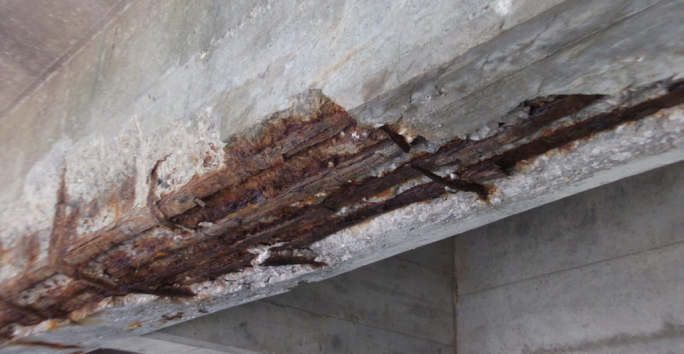
In concrete, steel is often embedded to reinforce the concrete, providing tensile and flexural strength. This combination of steel and concrete allows for some of the most durable and beautiful structures to be built. Concrete, as a building material, has superior compressive strength to most materials, and is durable in many different exposure environments. However, on it’s own, concrete does not possess sufficient tensile and flexural strength to be used in many structures. Steel, as a building material, has superior tensile and flexural strength. Steel on it’s own is susceptible to corrosion and will corrode over time. Together, the strengths of concrete and steel compliment each other and together make a remarkable building material that has sufficient compressive, tensile, and flexural strength, and is able to withstand most environmental conditions.
The cement in concrete has a high pH, usually around 13-14, and can even be higher. When steel reinforcement is embedded in concrete, a passivation layer is formed around the steel from being exposed to the high alkaline environment. This passivation layer formed on the steel is an oxide layer that protects the embedded rebar from corrosion. When the passivation layer is present, the steel reinforcement is protected from corrosion caused by the elements and from chloride present at concentrations below 0.02% (w/w) by mass of concrete.
The passivation layer does not protect embedded steel from corrosion when the chloride concentration is above 0.02% (w/w) by mass of concrete. Corrosion of any embedded steel can be promoted by the chloride present when it is above this threshold, even when the passivation layer is present on the surface of the reinforcing steel.
Carbonation of the the cement paste (hydrated cement portion of the concrete), while not actively contributing to the corrosion of steel, can allow for corrosion to occur. Carbonation occurs when infiltration of atmospheric carbon dioxide into the concrete reacts with the cement paste. The pH of cured concrete is typically 11 to 13, but carbonation lowers the pH of the cured cement paste, which eliminates any protection provided to the embedded steel which was provided by the high alkaline environment. It is important to note that when the concrete becomes carbonated, any amount of chloride present in the concrete will accelerate the rate of corrosion.

A few simple tests can be performed to determine whether the concrete is carbonated. Depth of carbonation testing uses phenolphthalein indicator to determine at what depth from the surface the paste has been carbonated. To perform depth of carbonation, the phenolphthalein is first dissolved in a suitable solvent such as ethanol or isopropanol. This mixture is applied to a freshly broken surface of the concrete. The surface of the concrete that turns bright pink is considered to not have significant carbonation. The surfaces that do not turn pink, and where the phenolphthalein indicator stays clear, are considered to be carbonated. There are instances where this test can produce lighter shades of pink, which can reduce the clarity and confidence of the results. In these cases, pH measurement is a good technique for determining the level of carbonation in the paste. Concrete that has been fully carbonated typically has a pH in the range 8.5 to 9. Though the passivation effect protecting the steel is lost at around pH 9.5 to 10.5. Phenolphthalein indicator typically changes color around pH 10 but can vary with different lots of phenolphthalein.
For more information contact Matt Anderson at 847.306.9240 or manderson@materialsanalyticalgroup.com. And for 15% off our services, let us know you have been reading our articles before receiving your invoice.


this informations give help to the material engineers and to all practicing civil engineers,thank you.
LikeLiked by 1 person
Thanks for checking out the article. I am glad it is helpful. I love to hear the feedback thanks again.
LikeLike